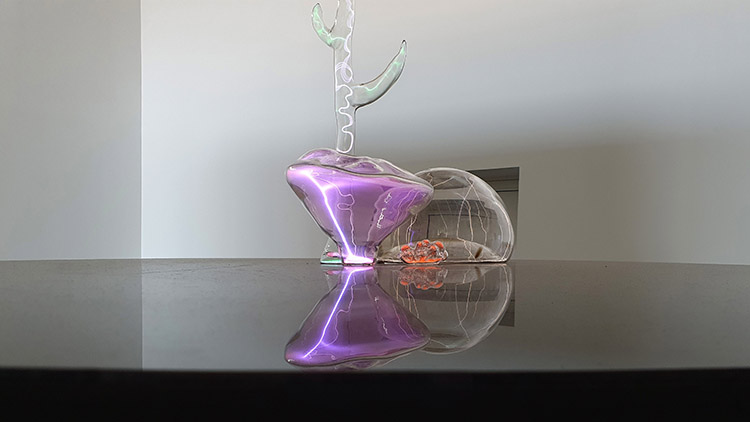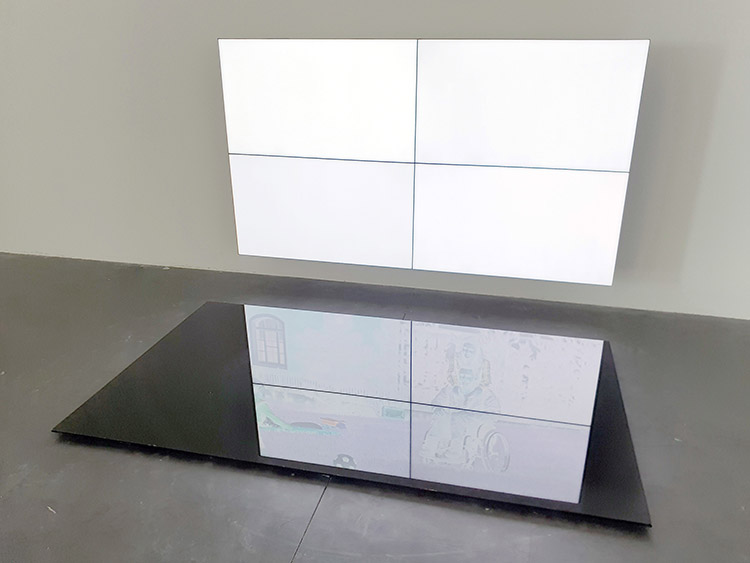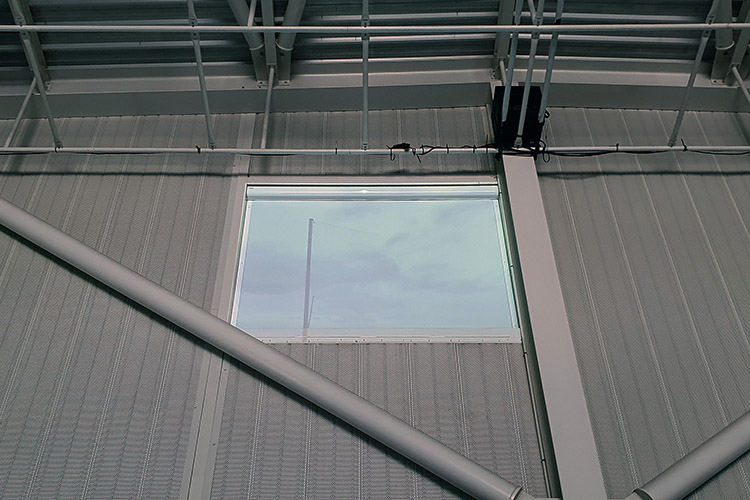Signal - Espace(s) Réciproque(s)
The European itinerant biennial Manifesta passes through Marseille for its 13th edition. In its wake, many artistic events are taking place, such as the exhibition Signal - Espace(s) Réciproque(s), which is being held at the Friche la Belle de Mai from a proposal by the Centre Wallonie-BruxellesMai.

Julien Maire, Composite, 2018-2020.
Signals, whatever their nature, imply that we deal with them in the same way as we do with information and communication technologies. These technologies are at the heart of Julien Maire's work, whose installation Composite welcomes us at the entrance of the exhibition space located in the Friche la Belle de Mai's panorama tower. A mysterious device whose function is unknown, is surrounded by screens. On one of them, we perceive antennas looking for signals coming from far away, hence from the past. It is by understanding that the device in question is a micrometric engraver that we realize that the drawings displayed on the screens have been engraved on the surfaces of the micro-camera sensors. The artist, whose attachment to capture techniques is well known, subsequently reactivated the cameras so that they filmed the space of the installation. We thus enter punctually into the images of the work whose video signals are augmented by drawings that alter them.

Claire Williams, Zoryas, electronic activity of the sun, 2019.
Claire Williams' light installation Zoryas, electronic activity of the sun also has an experimental aspect, as its appearance calls to mind the scientific apparati of the 19th century. The show is performed inside organic shaped glass containers. The energy that unfolds inside the containers is a display of the ionization of noble gases by magnetic fields. In visual art as in natural sciences, observation is an essential step, where wonder is conducive to both imagination and understanding. The phenomena that the artist activates appear without scale for those who agree to immerse themselves in the work. The sound accompanying what happens before our eyes is also perceptible through the bone conduction of our elbows resting on the experimentation table. This is how Zoryas expands our imagination to the cosmos, where phenomena occur that we cannot yet explain because we have not yet observed them.

Emmanuel van der Auwera, Vidéosculpture XIV (Shudder), 2017.
One of the themes of this exhibition is the invisible, which is particularly well represented by Emmanuel van der Auwera's installation Vidéosculpture XIV (Shudder), because the screens that comprise it do not allow us to visualize the images – which are film archives - that they nevertheless broadcast. The sequences are in fact transmitted by a black shimmering surface located on the ground that reflects them. In the 17th century, the painter Claude Lorrain used to observe the world through such a device, which was referred to as the ‘Claude glass’. For reality, sometimes, must be observed through stratagems. This is what scientists, in their observation practices, will confirm. The Belgian artist's video sculpture thus approaches the question of point of view, dear to painters, associated with the use of filters as they are used in photography and, by extension, in cinema, which Emmanuel van der Auwera only seeks to extend.

Edith Dekyndt, One Second of Silence (part 1, New-York), 2008-2009.
The question of point of view is omnipresent in this exhibition, even in its scenography. Spectators must indeed scrutinize the space well beyond their usual field of vision to locate all the creations presented there. Even so, there is nothing extraordinary about presenting a flag high up, as is the case with Edith Dekyndt's flag. And it is on its pole that the flag can be seen in the video sequence that documents it. For what seems to float in the wind is transparent, and the artist associates this form of invisibility with John Cage's work on silence. The eradication of all the colours of such a flag distances it from the nations it usually represents. By a radical act, this minimal flag thus becomes possibly that of all the countries of the world. A certain idea of living together that politics frequently refutes, but which would still have its place in the sphere of art, and more broadly of ideas.

Eva l’Hoest, Under Automata, 2016.
Finally, among the twenty or so works presented with this idea of observing the world differently, there is the video installation entitled Under Automata. Produced by Eva l’Hoest, this new genre of film was not shot with a camera but captured with a scanner. It shows people sleeping in the extended duration of a long-haul flight. Slowness and torpor are apparent and nothing more than an interminable wait are all that is happening. The process used fuses the bodies distorted by the lack of information with the seats in the front row. Only the lateral traveling of an endless corridor is cinematic. For their part, the images are more about computation than about the lens. Cinema, from the very premises of its invention, is irremediably linked to the technologies that organize its regular mutations. Here again, it is a form of expanded cinema that emerged from the use of video, whose images from the beginning have been broadcast by a signal.
Articles
- Paris Photo
- Art, technology and AI
- Immersive Art
- Chroniques Biennial
- 7th Elektra Biennial
- 60th Venice Biennial
- Endless Variations
- Multitude & Singularity
- Another perspective
- The Fusion of Possibilities
- Persistence & Exploration
- Image 3.0
- BioMedia
- 59th Venice Biennale
- Decision Making
- Intelligence in art
- Ars Electronica 2021
- Art & NFT
- Metamorphosis
- An atypical year
- Real Feelings
- Signal - Espace(s) Réciproque(s)
- On Combinations at Work
- Human Learning
- Attitudes and forms by women
- Ars Electronica 2019
- 58th Venice Biennale
- Art, Technology and Trends
- Art in Brussels
- Plurality Of Digital Practices
- The Chroniques Biennial
- Ars Electronica 2018
- Montreal BIAN 2018
- Art In The Age Of The Internet
- Art Brussels 2018
- At ZKM in Karlsruhe
- Lyon Biennale 2017
- Ars Electronica 2017
- Digital Media at Fresnoy
- Art Basel 2017
- 57th Venice Biennial
- Art Brussels 2017
- Ars Electronica, bits and atoms
- The BIAN Montreal: Automata
- Japan, art and innovation
- Electronic Superhighway
- Lyon Biennale 2015
- Ars Electronica 2015
- Art Basel 2015
- The WRO Biennale
- The 56th Venice Biennale
- TodaysArt, The Hague, 2014
- Ars Electronica 2014
- Basel - Digital in Art
- The BIAN Montreal: Physical/ity
- Berlin, festivals and galleries
- Unpainted Munich
- Lyon biennial and then
- Ars Electronica, Total Recall
- The 55th Venice Biennale
- The Elektra Festival of Montreal
- Digital practices of contemporary art
- Berlin, arts technologies and events
- Sound Art @ ZKM, MAC & 104
- Ars Electronica 2012
- Panorama, the fourteenth
- International Digital Arts Biennial
- ZKM, Transmediale, Ikeda and Bartholl
- The Gaîté Lyrique - a year already
- TodaysArt, Almost Cinema and STRP
- The Ars Electronica Festival in Linz
- 54th Venice Biennial
- Elektra, Montreal, 2011
- Pixelache, Helsinki, 2011
- Transmediale, Berlin, 2011
- The STRP festival of Eindhoven
- Ars Electronica repairs the world
- Festivals in the Île-de-France
- Trends in Art Today
- Emerging artistic practices
- The Angel of History
- The Lyon Biennial
- Ars Electronica, Human Nature
- The Venice Biennial
- Nemo & Co
- From Karlsruhe to Berlin
- Media Art in London
- Youniverse, the Seville Biennial
- Ars Electronica, a new cultural economy
- Social Networks and Sonic Practices
- Skin, Media and Interfaces
- Sparks, Pixels and Festivals
- Digital Art in Belgium
- Image Territories, The Fresnoy
- Ars Electronica, goodbye privacy
- Digital Art in Montreal
- C3, ZKM & V2
- Les arts médiatiques en Allemagne
- Grégory Chatonsky
- Le festival Arborescence 2006
- Sept ans d'Art Outsiders
- Le festival Ars Electronica 2006
- Le festival Sonar 2006
- La performance audiovisuelle
- Le festival Transmediale 2006
- Antoine Schmitt
- Eduardo Kac
- Captations et traitements temps réel
- Maurice Benayoun
- Japon, au pays des médias émergents
- Stéphane Maguet
- Les arts numériques à New York